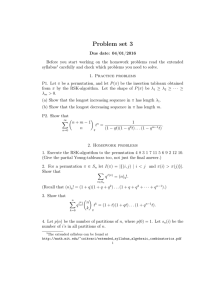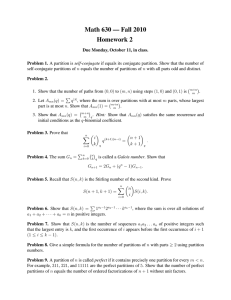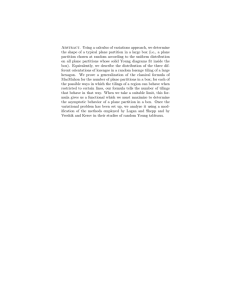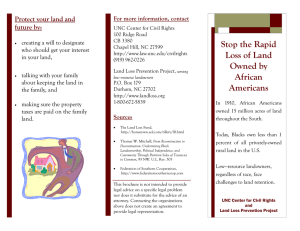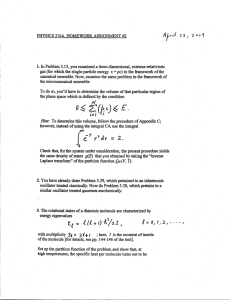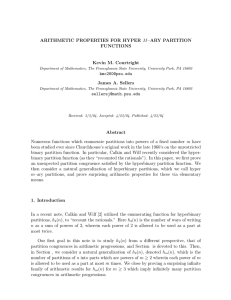PARTITIONS WHICH ARE J.-C. Puchta
advertisement
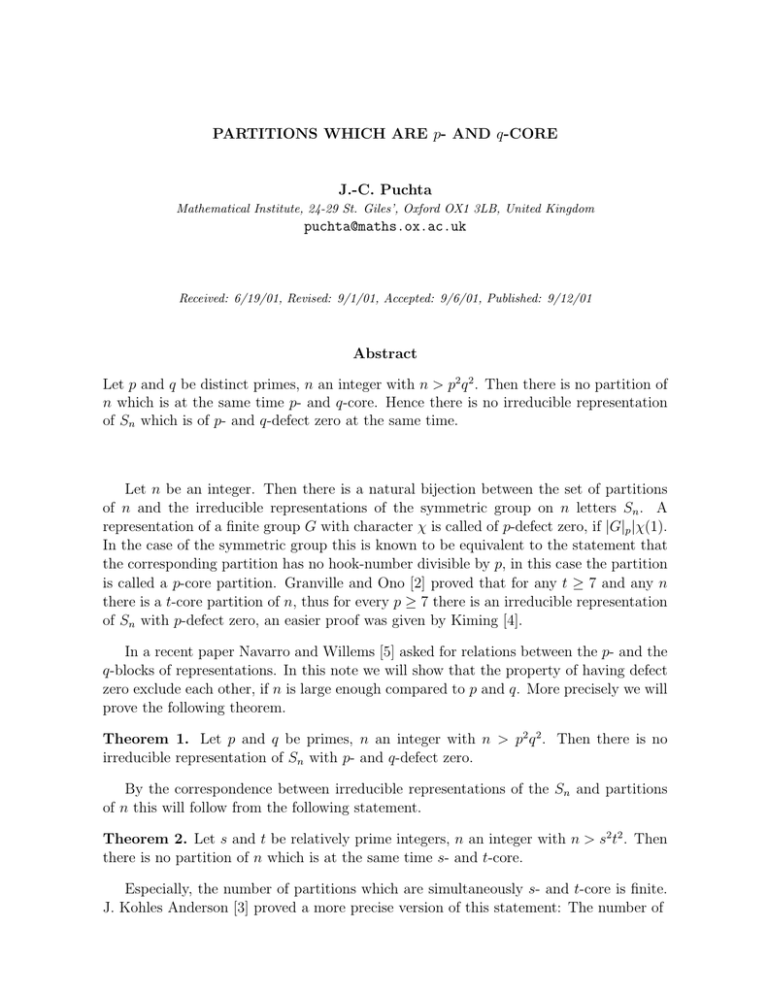
PARTITIONS WHICH ARE p- AND q-CORE J.-C. Puchta Mathematical Institute, 24-29 St. Giles’, Oxford OX1 3LB, United Kingdom puchta@maths.ox.ac.uk Received: 6/19/01, Revised: 9/1/01, Accepted: 9/6/01, Published: 9/12/01 Abstract Let p and q be distinct primes, n an integer with n > p2 q 2 . Then there is no partition of n which is at the same time p- and q-core. Hence there is no irreducible representation of Sn which is of p- and q-defect zero at the same time. Let n be an integer. Then there is a natural bijection between the set of partitions of n and the irreducible representations of the symmetric group on n letters Sn . A representation of a finite group G with character χ is called of p-defect zero, if |G|p |χ(1). In the case of the symmetric group this is known to be equivalent to the statement that the corresponding partition has no hook-number divisible by p, in this case the partition is called a p-core partition. Granville and Ono [2] proved that for any t ≥ 7 and any n there is a t-core partition of n, thus for every p ≥ 7 there is an irreducible representation of Sn with p-defect zero, an easier proof was given by Kiming [4]. In a recent paper Navarro and Willems [5] asked for relations between the p- and the q-blocks of representations. In this note we will show that the property of having defect zero exclude each other, if n is large enough compared to p and q. More precisely we will prove the following theorem. Theorem 1. Let p and q be primes, n an integer with n > p2 q 2 . Then there is no irreducible representation of Sn with p- and q-defect zero. By the correspondence between irreducible representations of the Sn and partitions of n this will follow from the following statement. Theorem 2. Let s and t be relatively prime integers, n an integer with n > s2 t2 . Then there is no partition of n which is at the same time s- and t-core. Especially, the number of partitions which are simultaneously s- and t-core is finite. J. Kohles Anderson [3] proved a more precise version of this statement: The number of INTEGERS: ELECTRONIC JOURNAL OF COMBINATORIAL NUMBER THEORY 1 (2001), #A06 1 partitions with this property is in fact equal to s+t here seems to be simpler then the one given by her. ³ s+t t ´ 2 . However, the proof we give I would like to thank the referee for making me aware of [3]. The proof will use the description of t-core partitions introduced by Garvan, Kim and Stanton [1]. For the sequel we choose an arbitrary partition n = λ1 + . . . + λk of n and assume that it is t-core and s-core at the same time. We thus have to show that n < s2 t2 . Consider the diagram of the partition, i.e. the set of cells whose first row consists of λ1 cells (1, 1), (1, 2), . . . , (1, λ1 ), the second of λ2 cells and so on. Label a cell (i, j) with j − i (mod st), cells in column 0 are labeled in the same way. A cell at the end of a row is called exposed. Now divide the diagram into regions Sk , such that a cell belongs to Sk if and only if s(k − 1) ≤ j − i < sk, in the same way Tk denotes the cells with t(k − 1) ≤ j − i < tk. Now by [1], paragraph 2, we know that if the partition is s-core, and there is an exposed cell labeled with i in the region Sk , then there is an exposed cell labeled with ĩ ≡ i (mod s) in every region Sl with l ≤ k. Especially, there is some sequence kν , 0 ≤ ν ≤ l, k0 = 1, such that λkν ≡ λ1 − (kν − 1) (mod s), (kν+1 − kν ) < λkν − λkν+1 < 2s − (kν+1 − kν ) and λkl < s, i.e. λkν = λ1 − νs + kν . Assume that l < t. Since λkν ≤ λkν+1 , we have kν+1 ≤ kν + s, thus the partition under consideration consists of at most ls < st summands, each being st at most, thus we have n ≤ s2 t2 . Now if l > t, then the labels of the exposed cells in the rows kν run through a complete remainder system (mod t), since s and t are coprime, the remainders of λkν − kν = λ1 − νs, 0 ≤ ν < t are therefore all different. However, by [1] we know that if the partition is t-core, and there is an exposed cell in region Tk with the label i, then there is no exposed cell with a label i ≡ t − i − 1 (mod t) in any region Tl with l ≥ 1 − k. If λ1 is in region Tk , then λkt−1 is in region Tl with l ≥ k − s, thus k − s < 1 − k, i.e. k ≤ s/2. By the definition of Tk we have λ1 < t(s/2 + 1) ≤ st. Since the property of being a t-core partition is unchanged under conjugation, by the same reasoning we get that there are less than st summands, thus we obtain n < s2 t2 again. Thus in any case the assumption that our partition is at the same time s-core and t-core leads to the estimate n < s2 t2 which proves our theorem. INTEGERS: ELECTRONIC JOURNAL OF COMBINATORIAL NUMBER THEORY 1 (2001), #A06 3 References [1] F. Garvan, D. Kim, D. Stanton, Cranks and t-cores, Invent. Math. 101, No.1, 1-17 (1990) [2] A. Granville, K. Ono, Defect zero p-block for finite simple groups, Trans. Am. Math. Soc. 348, No.1, 331-347 (1996) [3] J. Kohles Anderson, Partitions which are simultaneously t1 - and t2 -core, to appear in Discrete Mathematics [4] I. Kiming, A note on a theorem of A. Granville and K. Ono, J. Number Theory 60, No.1, 97-102 (1996) [5] G. Navarro, W. Willems, When is a p-block a q-block?, Proc. Am. Math. Soc. 125, No.6, 1589-1591 (1997) Mathematics Subject Classification: 05A17, 11P83, 20C30


